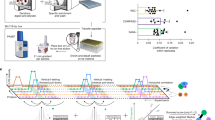Abstract
An interactome describes the global organization of protein interactions within a cell and is typically generated using affinity purification-mass spectrometry (AP-MS), yeast two-hybrid screening, or protein-fragment complementation assays (Gavin et al. Nature 440: 631–636, 2006; Krogan et al. Nature 440: 637–643, 2006; Uetz et al. Nature 403: 623–627, 2000; Tarassov et al. Science 320: 1465–1470, 2008). These techniques have been widely used to depict the interactome as we know it today but current models of interactomes do not contain stoichiometric or temporal information. In this chapter we describe size-exclusion chromatography (SEC) combined with protein correlation profiling-stable isotope labeling by amino acids in cell culture (PCP-SILAC) to generate dynamic chromatographs for thousands of proteins (Kristensen et al. Nat Methods 9: 907–909, 2012). Using the precise co-elution of two proteins as evidence that they interact, it is possible to identify similar numbers of protein interactions without overexpression or creating fusion proteins as other high-throughput techniques require. In addition, triplex SILAC allows us to quantify protein stoichiometry and temporal changes to the interactome following perturbation. Finally, SEC-PCP-SILAC is very time efficient since it generates two orders of magnitude fewer samples for LC-MS analysis and avoids the tedious tagging and purification steps, making it possible for everyone with a single mass spectrometer to study the interactome.
Access this chapter
Tax calculation will be finalised at checkout
Purchases are for personal use only
Similar content being viewed by others
References
Gavin A-C, Aloy P, Grandi P et al (2006) Proteome survey reveals modularity of the yeast cell machinery. Nature 440:631–636
Krogan NJ, Cagney G, Yu H et al (2006) Global landscape of protein complexes in the yeast Saccharomyces cerevisiae. Nature 440:637–643
Werner JN, Chen EY, Guberman JM et al (2009) Quantitative genome-scale analysis of protein localization in an asymmetric bacterium. Proc Natl Acad Sci U S A 106:7858–7863
Andersen JS, Wilkinson CJ, Mayor T et al (2003) Proteomic characterization of the human centrosome by protein correlation profiling. Nature 426:570–574
Andersen JS, Lam YW, Leung AKL et al (2005) Nucleolar proteome dynamics. Nature 433:77–83
Foster LJ, de Hoog CL, Zhang Y et al (2006) A mammalian organelle map by protein correlation profiling. Cell 125:187–199
Jakobsen L, Vanselow K, Skogs M et al (2011) Novel asymmetrically localizing components of human centrosomes identified by complementary proteomics methods. EMBO J 30:1520–1535
Dengjel J, Hoyer-Hansen M, Nielsen MO et al (2012) Identification of autophagosome-associated proteins and regulators by quantitative proteomic analysis and genetic screens. Mol Cell Proteomics 11:M111.014035
Kristensen AR, Gsponer J, Foster LJ (2012) A high-throughput approach for measuring temporal changes in the interactome. Nat Methods 9:907–909
Ong S-E, Blagoev B, Kratchmarova I et al (2002) Stable isotope labeling by amino acids in cell culture, SILAC, as a simple and accurate approach to expression proteomics. Mol Cell Proteomics 1:376–386
Ong S-E, Mann M (2007) A practical recipe for stable isotope labeling by amino acids in cell culture (SILAC). Nat Protoc 1:2650–2660
Rappsilber J, Mann M, Ishihama Y (2007) Protocol for micro-purification, enrichment, pre-fractionation and storage of peptides for proteomics using StageTips. Nat Protoc 2:1896–1906
Rappsilber J, Ishihama Y, Mann M (2003) Stop and go extraction tips for matrix-assisted laser desorption/ionization, nanoelectrospray, and LC/MS sample pretreatment in proteomics. Anal Chem 75:663–670
Cox J, Mann M (2008) MaxQuant enables high peptide identification rates, individualized p.p.b.-range mass accuracies and proteome-wide protein quantification. Nat Biotechnol 26:1367–1372
Olsen JV, Vermeulen M, Santamaria A et al (2010) Quantitative phosphoproteomics reveals widespread full phosphorylation site occupancy during mitosis. Sci Signal 3:ra3
Lachenbruch PA, Mickey MR (1968) Estimation of error rates in discriminant analysis. Technometrics 10:1–11
Author information
Authors and Affiliations
Corresponding author
Editor information
Editors and Affiliations
Rights and permissions
Copyright information
© 2014 Springer Science+Business Media New York
About this protocol
Cite this protocol
Kristensen, A.R., Foster, L.J. (2014). Protein Correlation Profiling-SILAC to Study Protein-Protein Interactions. In: Warscheid, B. (eds) Stable Isotope Labeling by Amino Acids in Cell Culture (SILAC). Methods in Molecular Biology, vol 1188. Humana Press, New York, NY. https://doi.org/10.1007/978-1-4939-1142-4_18
Download citation
DOI: https://doi.org/10.1007/978-1-4939-1142-4_18
Published:
Publisher Name: Humana Press, New York, NY
Print ISBN: 978-1-4939-1141-7
Online ISBN: 978-1-4939-1142-4
eBook Packages: Springer Protocols




